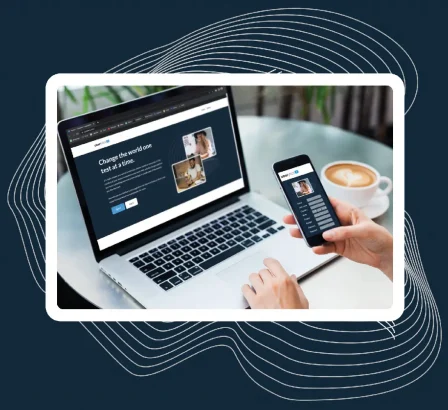
In the ever-evolving realm of user experience (UX) design, research acts as the compass that guides designers towards creating delightful and intuitive digital experiences.
As UX designers, we understand the vital role research plays in uncovering user insights, informing design decisions, and ultimately delivering exceptional products. However, within the expansive field of UX research, two dominant methodologies reign supreme: qualitative and quantitative research.
Qualitative and quantitative approaches each offer distinct lenses through which we can view user behavior, preferences, and needs. Yet, the question often arises: which research methodology should UX designers embrace to extract meaningful insights and optimize their design process?
In this article, we embark on a journey to demystify the complexities of qualitative and quantitative UX research specifically tailored to the discerning minds of UX designers.
What Is Quantitative UX Research
Quantitative UX research is a systematic approach to gathering and analyzing numerical data to gain insights into user behavior and preferences. It involves collecting data on a large scale, often through surveys, experiments, and analytics, with the goal of obtaining statistically significant results.
In quantitative UX research, designers use metrics, measurements, and statistical analysis to quantify user behaviors, attitudes, and opinions. The focus is on generating objective and measurable data that can be analyzed to identify patterns, trends, and correlations.
This data-driven approach provides designers with quantitative evidence to support decision-making throughout the design process.
Quantitative research in UX provides designers with valuable insights into user behavior at scale, helping them make data-informed decisions, identify usability issues, validate design hypotheses, and track the impact of design changes over time.
It complements qualitative research by providing a broader understanding of user preferences and behaviors, allowing designers to make informed decisions based on statistically significant data. Let’s review the various quantitative ux research methods.
Quantitative UX Research Methods
There are several quantitative UX research methods that designers can employ to gather data and insights. Here are some commonly used quantitative methods in the field of UX:
- Surveys: Surveys are one of the several quantitative research methods. It involves collecting data from a large number of participants using structured questionnaires. They can be administered online or in person and are useful for gathering information on user preferences, satisfaction, demographics, and more.
- A/B Testing: A/B testing -one of the most common quantitative user research methods- compares two or more variations of a design element or feature to determine which performs better based on predefined metrics. It allows designers to test hypotheses, evaluate design choices, and optimize user experiences.
- Analytics and User Tracking: Utilizing web analytics tools or tracking software, designers can gather quantitative data on user behavior within a digital product. Metrics such as click-through rates, page views, time spent on pages, or conversion rates provide insights into user engagement and interactions.
- Behavioral Analysis: Behavioral analysis involves studying large-scale user behavior data to identify patterns and trends. This can include analyzing user flows, funnels, drop-off points, or frequency of interactions to gain insights into user journeys and optimize the user experience.
- Task Performance Metrics: Task performance metrics measure specific aspects of user performance, such as task completion time, error rates, or efficiency. These metrics provide quantitative data on the usability and effectiveness of a design and can help identify areas for improvement.
- Eye Tracking: Eye tracking technology is used to measure and analyze where users look on a screen or interface. It provides quantitative data on visual attention, gaze patterns, and heat maps, which can inform design decisions related to visual hierarchy, information placement, and visual cues.
- Clickstream Analysis: Clickstream analysis involves analyzing the sequence of user actions and interactions within a digital product. It helps identify navigation patterns, user flows, and areas of interest or concern.
- Quantitative Interviews: In quantitative interviews, researchers use a structured interview format to ask predefined questions to participants. The responses are quantified and analyzed for statistical trends and patterns.
These are just a few examples of quantitative UX research methods. Each method has its strengths and limitations, and the choice of methods depends on the research objectives, the target audience, and the available resources.
Often, a combination of qualitative and quantitative research methods can provide a more comprehensive understanding of the user experience.
Expert Considerations to Effectively Do Quantitative UX Research
Quantitative UX reasearch and successfuly interpreting quantitative metrics requires certain aspects that every UX researcher must keep in mind.
1. Plan for high-quality and relevant quantitative UX data

Proper interpretation of quantitative UX metrics starts before gathering any data. There are overarching questions that practitioners need to ask to keep on track and make sound interpretations.
Some questions to consider are: What are the goals and objectives of the quantitative research you are gathering? What research questions are attempting to be answered with quantitative UX metrics? What methods will be used to interpret data? Who are the stakeholders who will use the data?
Investing the time to define and answer these questions allow UX researchers to focus on highly relevant metrics to goals and objectives.
2. Focus on UX-related metrics and not business metrics

There can be an overwhelming amount of metrics for business analytics. So the first step is to narrow it down so that time isn’t wasted focusing on irrelevant data to UX.
Pro tips: understand UX Metrics versus KPIs.
UX Metrics are quantitative data used to measure, compare, and track users’ experience interacting with a digital product over time. These are associated with user behaviors and attitudes. KPIs (key performance indicators) are quantitative data used to measure, compare, and track the overall goals. These goals typically are tied to revenue, growth, retention, and user counts.
It is essential to focus on UX data that aligns with your goals and objectives for research.
3. Have a streamlined data wrangling process in place

A critical part of the quantitative data interpretative process is ensuring data is reliable before analyzing and leveraging it for insights. At this junction is where data wrangling (the process of discovering, structuring, cleaning, enriching, validating, and publishing the data) comes in. This process can be very lengthy and time-consuming.
Data professionals spend as much as 80% of their time preparing data for analysis. UX professionals cannot afford this much of their time to be sucked up in cleaning and organizing data. But suppose your research operations have streamlined processes for how to wrangle data. In that case, this saves a lot of time and removes the risk of gleaning insights and making interpretations from incomplete, unreliable, or inconsistent data.
4. Use storytelling to communicate findings

Data visualization is an art. And explaining data visuals is a craft. Not many can do these two things well. This is why storytelling is such a powerful skill. Graphs and charts are great, but if a researcher cannot tell a story to explain the data, the findings have minimal impact on business decisions. Additionally, people, including business leaders, are moved by stories.
It is essential to know how to choose the right data visualization type. Generally, there are four goals for data visualization types: 1. showing relationships, 2. showing distribution, 3. showing the composition, or 4. making comparisons.
Asking the following questions will help you define the best visualization type for the right audience:
- What is the story you want to tell?
- Who is the audience you want to tell the story to?
- Do we want to analyze trends?
- Do we want to demonstrate composition?
- Do we want to compare two or more sets of values?
- Do we want to show changes over time?
- How will we show UX Metrics?
Once these questions are answered, it becomes easier to decide if a pie chart, a line chart, a spider chart, a bar chart, or a scatter plot is the best visualization type to tell the user experience story.
5. Synthesize your insights and draw valuable conclusions

Now comes the moment where the synthesis of quantitative UX metrics data serves as a change agent for the user experience. Extract facts from the data. Remain objective by being aware of the pitfalls previously discussed. And make interpretations of the data. The goal is to generate valuable recommendations.
Good recommendations are:
- Constructive. They offer a solution rather than focusing on the problem revealed by the data.
- Specific. They identify wherein the user experience recommendations are most applicable.
- Actionable. Suggestions should be active. Use language that is active rather than passive to inspire change.
- Concise. Plenty of recommendations can be generated from any given set of UX data, but not all of them will significantly impact the user experience. Prioritize the most important ones.
- Measurable. Good recommendations can be measured so that there can be evidence a change has occurred and an impact has been made.
- Balanced. Identify both the strengths and weaknesses.
What is Qualitative UX Research
Qualitative UX research is an investigative approach that focuses on gathering rich, descriptive insights and understanding the subjective experiences, attitudes, and motivations of users.
Unlike quantitative research, qualitative research aims to uncover the “why” behind user behavior rather than focusing solely on numerical data.
Qualitative UX research methods involve observing and engaging with users in a more open-ended and exploratory manner, allowing for in-depth exploration of user perspectives.
This type of research provides designers with a deep understanding of user needs, pain points, and aspirations, which can inform design decisions and drive empathy-driven solutions.
Qualitative research allows designers to gain a deeper understanding of user needs, motivations, and emotions. It helps uncover nuances, user pain points, and opportunities for improvement that quantitative data alone may not reveal.
By leveraging qualitative insights, designers can generate empathy, enhance user engagement, and create user-centered experiences that address real user challenges.
It’s worth noting that qualitative and quantitative research are often used together in a complementary manner, with qualitative research providing a foundation for hypothesis generation and quantitative research validating and measuring the impact of design decisions.
Qualitative research methods in UX
Qualitative research methods focus on gathering rich, in-depth insights into user experiences, attitudes, and motivations.
These qualitative user research methods allow designers to understand the “why” behind user behavior and provide valuable context for design decisions. Here are some commonly used qualitative research methods in UX:
- User Interviews: These qualitative methods require one-on-one or group interviews with participants to gather detailed information about their experiences, behaviors, needs, and goals. These interviews can be structured or semi-structured, allowing for open-ended discussions.
- Contextual Inquiry: Observe users in their natural environment while they engage with a product or service. This method provides insights into how users interact with a design in real-life situations, uncovers pain points, and identifies opportunities for improvement.
- Diary Studies: Ask participants to keep a diary or journal to record their experiences, thoughts, and behaviors over a specific period. Diary studies provide longitudinal insights into users’ lives, allowing designers to understand their daily routines, challenges, and emotional responses.
- Usability Testing with Think Aloud: A solid approach is to observe users as they perform tasks while verbalizing their thoughts and impressions. This method provides real-time insights into users’ decision-making processes, frustrations, and successes during the interaction with a design.
- Focus Groups: Facilitate group discussions with participants to explore shared experiences, opinions, and perceptions. Focus groups encourage participants to build upon each other’s ideas, generate insights, and identify common themes or patterns.
- Card Sorting: Engage users in organizing and categorizing information by asking them to sort and group items into meaningful categories. This method helps designers understand users’ mental models and how they perceive and organize information.
- Cognitive Walkthroughs: Walk through a design or prototype with participants while they share their thoughts and decision-making process. Cognitive walkthroughs help identify potential usability issues and gaps in user understanding.
- Ethnographic Research: Conduct in-depth, immersive studies in users’ natural environments over an extended period. Ethnographic research allows designers to deeply understand users’ cultural context, behaviors, and needs.
- Emotional Mapping: Use techniques such as user diaries, interviews, or visual exercises to explore users’ emotional responses and associations with a product or service. Emotional mapping helps designers create emotionally resonant experiences.
- Prototype Testing and Iteration: One of the several qualitative methods is tp share low-fidelity or high-fidelity prototypes with users and gather their feedback through observations, interviews, or usability testing. Prototyping allows designers to validate ideas, refine designs, and iterate based on user insights.
These qualitative research methods provide rich data and insights that go beyond numbers and metrics, helping designers gain a deep understanding of users’ experiences, perceptions, and needs. Combining different methods can offer a comprehensive view of user perspectives and inform user-centered design decisions.
Expert Considerations to Effectively Do Quantitative UX Research
When conducting quantitative UX research, there are several expert considerations to keep in mind to ensure the effectiveness of your study. Here are some key considerations.
1. Clearly define research objectives
Begin by defining clear and specific research objectives. Clearly articulate what you aim to achieve through your quantitative research and what specific questions you want to answer. This will guide your study design and data analysis.
2. Use validated measurement instruments
When selecting or creating measurement instruments such as surveys or questionnaires, use established and validated tools whenever possible. Validated instruments have been rigorously tested for reliability and validity, ensuring the accuracy and consistency of the data collected.
3. Pay attention to sampling and avoid bias in data collection
Ensure that your sample is representative of your target population or user group. Consider factors such as demographics, user characteristics, or usage patterns when selecting participants. A well-designed sampling strategy is crucial for the generalizability and validity of your findings.
Also, take steps to minimize bias in data collection. Provide clear instructions to participants, use neutral language, and avoid leading questions that may influence their responses. Additionally, consider factors such as the order of questions or the presentation of stimuli to mitigate potential biases.
4. Collect sufficient data
Ensure that your sample size is adequate to achieve statistical significance. Power analysis can help determine the appropriate sample size based on the effect size you expect to detect, the desired level of confidence, and statistical power.
5. Use appropriate statistical analysis and consider mixed methods
Choose appropriate statistical methods to analyze your quantitative data. Descriptive statistics, inferential statistics (e.g., t-tests, ANOVA, regression), and correlation analysis are common techniques used in quantitative UX research. Consult with a statistician if needed to ensure the accuracy and validity of your analysis.
Also, consider combining quantitative data with qualitative insights to gain a more comprehensive understanding. Integrating qualitative data can provide valuable context and shed light on the “why” behind quantitative findings, enriching the interpretation of your results.
6. Interpret results within context and communicate findings effectively
Interpret your quantitative findings in the context of your research objectives, user behavior, and broader UX considerations. Avoid drawing overly simplistic or misleading conclusions and consider alternative explanations or factors that may influence the results.
Also, present your quantitative findings in a clear and concise manner, using visualizations and data summaries that are easily understandable to both technical and non-technical stakeholders. Clearly communicate limitations and uncertainties associated with the research findings.
7. Iterate and refine
Remember that quantitative UX research is an iterative process. Continuously refine your research methods based on feedback, learnings, and new insights gained. Use findings to inform design iterations and further research efforts.
Conclusion
For UX practitioners, the volume of quantitative data available in today’s digital world is vast. And correctly interpreting quantitative UX metrics can be a daunting task. While it’s worth investing in highly technical skills, often, it’s more about processes that enable sound interpretations of UX metrics. The key is to remain objective, focus on relevant data, have simplified procedures for data cleaning and analysis, tell a good story with said data, and draw valuable conclusions to improve the user experience. Interpreting quantitative UX metrics is more about the process than sophistication in statistical knowledge (some tools take care of this). The goal is to have simplified, focused, and repeatable processes.
Interested in UX Testing?
Data Visualizations
About the author: Huyen Hoang
Huyen Hoang is a User Experience Researcher at Codelitt. Codelitt helps companies create better product experiences for their users by designing and building people-driven solutions with the speed, technology, and innovation of a startup.
About the Author: Collaborations

Our blog collaborators are a diverse group of professionals with extensive knowledge and experience in the field of user experience. They include UX researchers, designers, thought leaders, and industry professionals who are passionate about sharing their insights and expertise with others.
As collaborators, they contribute thoughtful and inspiring content that covers various aspects of the UX space, including emerging trends, best practices, and practical tips. Their articles are designed to help readers stay up-to-date with the latest developments in UX, as well as improve their own skills and knowledge in the field.
Read More Articles by Our Collaborators



